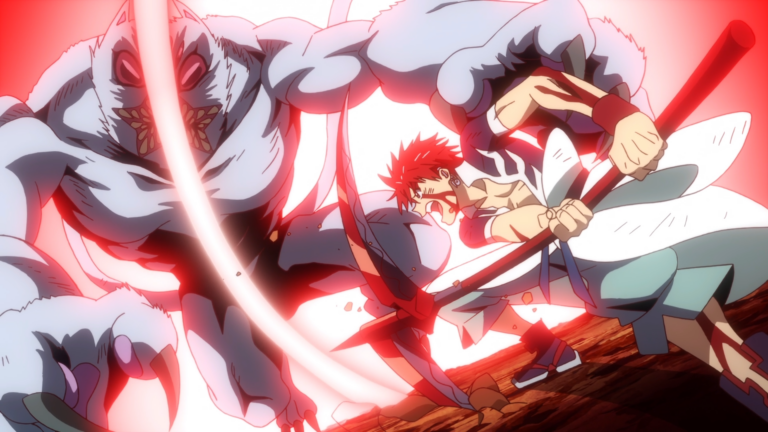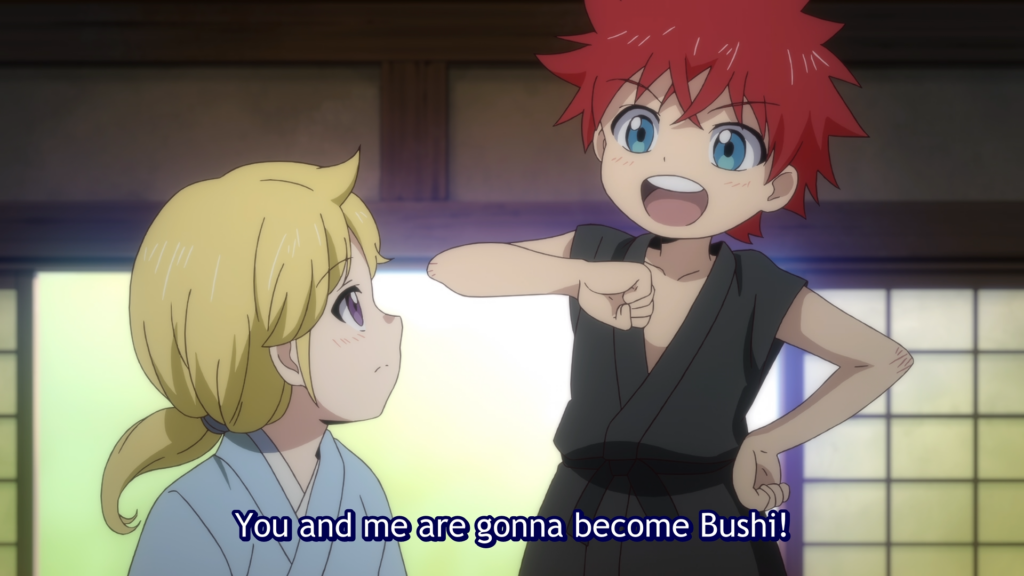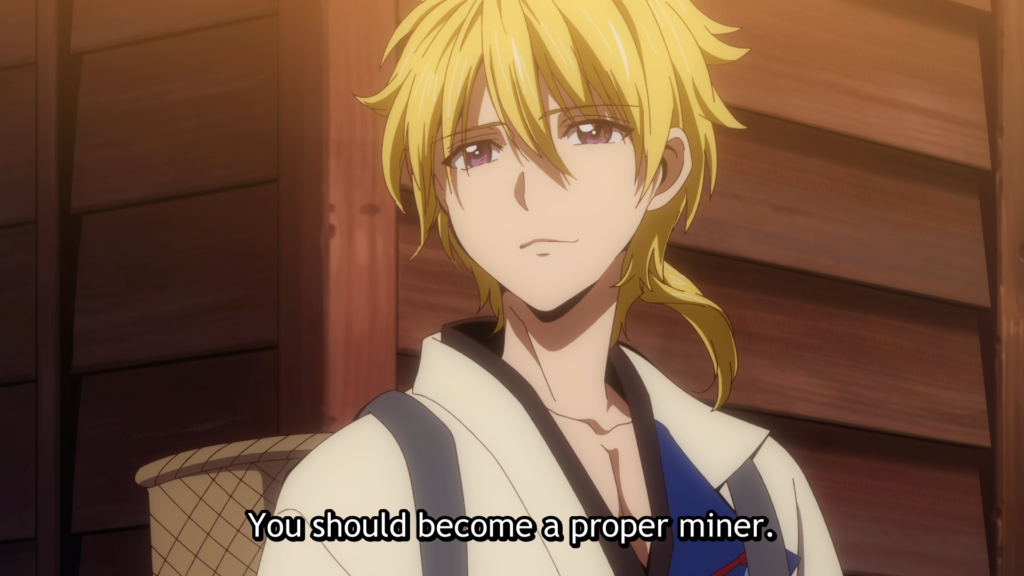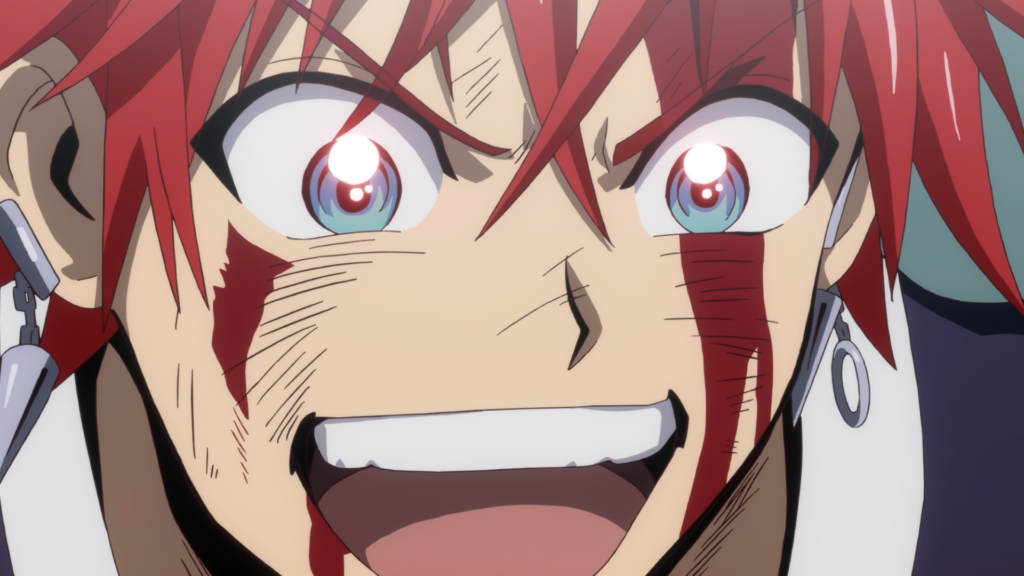Award-winning mangaka Shinobu Ohtaka is best known for Magi — but Orient is yet another spectacular story. Like Magi, Orient episode 1 paced its character introduction well. The episode focuses on the core characters and an explanation of the world. This is well invested time; because of the heavy exposition blended into character-driven flashbacks, viewers learn in two ways. In one way, we learn about the unique blend of fact and fiction in Orient episode 1. The anime takes place during the Sengoku period, also known as the warring states period. In actual history, this period broke out from power clashes between land-owning clans and the samurai who served them. Orient episode 1, while blending in fantasy elements, sits within this historical context and uses it to ground the lives of its characters.
In another way, viewers learn about the characteristics of both of our main characters, Musashi and Kojiro, and the mindset of the collective “mob” which makes up the vast majority of other characters. This second stream is where Orient episode 1 truly shines. While the animation is a bit sloppy at times, the story and characters are very much the opposite. Protagonists Musashi and Kojiro are based on real-life swordsmen Miyamoto Musashi and Sasaki Kojiro. Just as the anime borrows from the dynamic of its real-life history, Orient episode 1 borrows from these figures’ dynamic as well. Musashi and Kojiro (both IRL and in the show!) have different approaches to swordplay. One is precise and careful in style, the other makes massive swings to absolutely destroy enemies.
The comparison between these two friends and sworn brothers is what drew me into the show. Most battle shonen begin in more or less the same fashion, but careful juxtaposition isn’t quite as common. In discussing that, I’ll be going over the events of Orient episode 1. Read on with that in mind.
Demonic Feudal Lords
Orient, as I mentioned before, takes place in the warring states period. The fantasy twist to this story is the presence of demons called Oni and Kishin. Long ago, these demons arrived and terrorized the world, uniting warring territories under their rule. The sole force that fought against them is a band of demon-slaying samurai called Bushi. Kojiro, one of the two protagonists, is descended from Bushi. His father raised both Musashi and Kojiro and taught them swordplay as well as the true history of the world before his passing.
That truth is flipped for the rest of the country. The average human worships Oni like Vedic gods, building massive statues with the likeness of benevolent gods. Segments of boys spend their lives training to be miners, eventually venturing out to live alongside Oni and fulfill what they think is a dream come true. All the while, the entire population is taught that Bushi, rather than being heroes, are dastardly villains who fought against a group who are essentially gods.
The skeleton of this concept isn’t groundbreaking. But, I do appreciate elements of it. Perhaps this is the history nerd in me but I’m a massive fan of anime that mirror real-life persecution. The idea of evil forces using faith and worship as a smokescreen for horrible actions isn’t at all new. The Oni, who force humans to work as slaves and consume them, aren’t too different from feudal lords to begin with too.
Grounding via Context
As we watch Musashi and Kojiro interact with the general population we get to see some interesting elements to their personalities. Both of them, in flashbacks, are incredibly happy kids who train in swordplay and smile constantly and honestly. As a teen, Kojiro lives ostracized as a Bushi descendant, painting his face with shame outwardly and seeming resigned to his fate. When he attempts to dissuade Musashi from abandoning his potential as a miner in favor of a life as a Bushi swordsman, he does so out of benevolence for his friend who actually has a choice.
Musashi disguises his face with a different method for the same purpose. He lives and trains like a miner-to-be, all the while practicing his unique style of swordplay in preparation for Bushi work. When he tries to leave his country alongside Kojiro, he does so because a life without his friend is a poor one. One protagonist wants his friend to preserve what he has. The other wants his friend to discover what they both want.
Two Faces of Faith
Personally, I think this style of interaction is what’ll keep me watching. I love comparing both of these characters in my head and Orient episode 1 kept those comparisons coming. Even more, the weapons the two use evoke the same juxtaposition as their personalities and outlooks. Musashi trains using a pickaxe while he mines, making him one of the best miners and, ironically, the perfect slave for the Oni. While he is forced by circumstance to live as a miner, those exact circumstances boost the strength he needs for his aggressive swordplay.
Kojiro, by virtue of being totally cut off from society, has all of the time in the world to train. The setting in which he lives is reminiscent of where plenty of anime protagonists want to train (real Demon Slayer vibes, actually) and his seclusion gives him time to perfect himself. As a child, he is required to carry a sword and it’s chained to him, signaling that, at some point, he likely wanted to throw away his identity. In Orient episode 1, his sword is loose on him and his skill in drawing and sheathing it is evidence of his continued training.
The Oni and their worshippers are facing combatants trained in a battleground of their oppressors’ creation. I like these two main characters quite a bit and I’m excited to see them going forward. I won’t pretend I’m at all satisfied with the quality of the art or animation thus far, but the structure of the story and the nature of its characters definitely make this a show to check out.
Images via VRV
©大高忍・講談社/「オリエント」製作委員会




Participate In Discussions